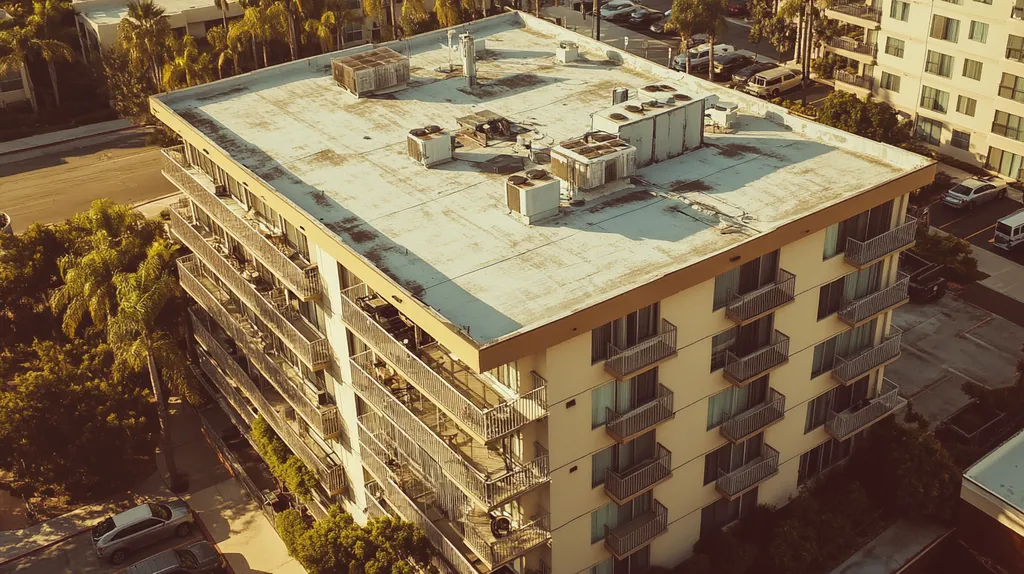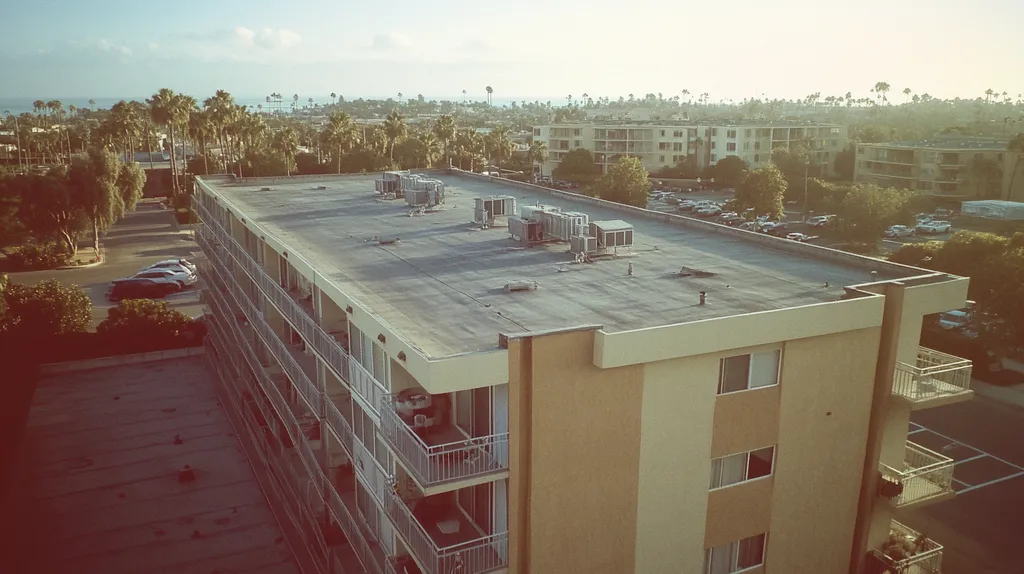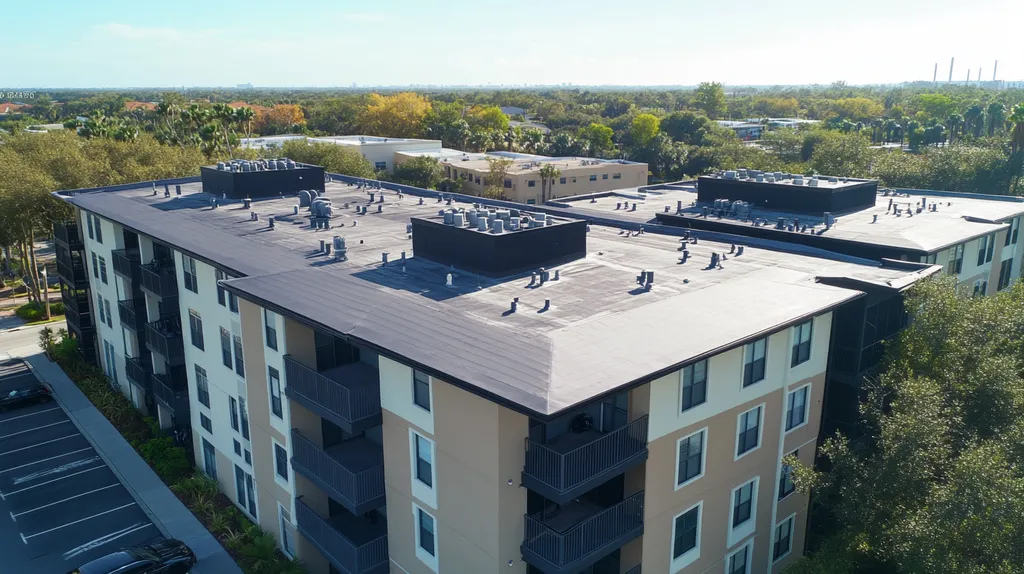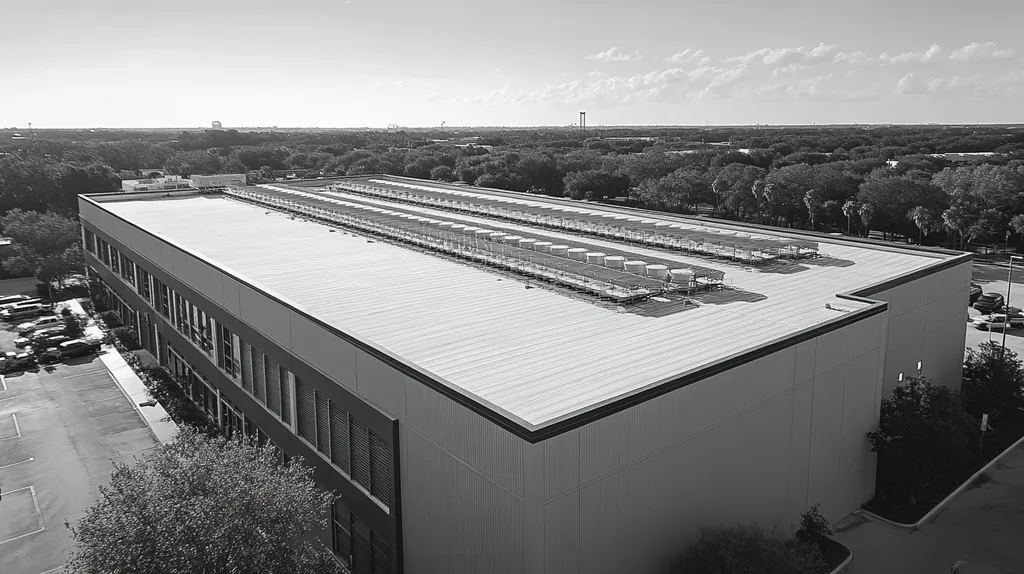Welcome to today’s Battle Royale featuring two roofing heavyweights: “Silicone Coatings” in the east corner versus “Polyurethane Coatings” in the west!
Tonight’s showdown pits these contenders against each other across six punishing rounds designed to test every aspect of their performance for Maintenance for Coated Commercial Roofs.
At stake? Millions in potential costs, decades of building protection, and the critical performance demands of modern commercial and industrial facilities.
Our professional judging panel will evaluate each round on technical merit, real-world performance, and value delivery. After all six rounds, we’ll declare our ultimate champion.
Ladies and gentlemen, facility managers and building owners… it’s time to rumble!
ROUND 1: INITIAL COSTS & INSTALLATION
When it comes to commercial roof coatings, the stakes couldn’t be higher. A coating decision impacts not just immediate expenses, but potentially decades of maintenance costs and headaches. With material costs soaring and skilled labor at a premium, property managers can’t afford to get this wrong.
Material Expenses
Let’s cut through the marketing fluff and talk real numbers. Silicone coatings command premium prices, often running 30-40% higher than their polyurethane cousins. But like that overpriced coffee maker that still works after a decade, there’s method to the madness.
Silicone coatings are the marathon runners of the roofing world. Their molecular structure remains stable under brutal UV exposure, requiring minimal thickness to achieve lasting protection. They’re essentially the “set it and forget it” option of roof coatings.
Polyurethane coatings seduce with their lower price tag, making CFOs everywhere smile. But like that bargain-basement printer that drinks expensive ink, the true cost reveals itself over time through more frequent recoating needs and maintenance.
Looking purely at material costs versus longevity, silicone’s durability gives it the clear ADVANTAGE in this category.
Installation Complexity
Think of silicone coating installation like conducting an orchestra – it requires precise timing, skilled performers, and perfect conditions. The application window is shorter, and surface prep must be immaculate. One wrong move can compromise adhesion.
Polyurethane coating installation is more forgiving, like a garage band that still sounds decent even if someone misses a note. It plays well with various substrates and provides more application flexibility.
However, this apparent simplicity can backfire. Polyurethane’s friendlier application process sometimes leads to complacency, resulting in shortcuts that compromise performance.
While both require professional installation, polyurethane’s more forgiving nature and wider application window give it the ADVANTAGE here.
Project Timeline
Silicone coatings demand patience. Surface preparation can’t be rushed, and cure times are fixed by chemistry, not wishful thinking. But like slow-cooking a gourmet meal, the results justify the wait.
Polyurethane installations move at a brisker pace. Multiple coats can often be applied in a single day, and cure times are generally shorter. For businesses where roof access disrupts operations, this speed advantage matters.
Yet speed isn’t everything. Rushed installations often lead to callbacks and premature failures. When weighing timeline benefits against long-term performance, polyurethane’s faster installation earns it the ADVANTAGE.
ROUND 1 WINNER: TIE
ROUND 2: DURABILITY & LIFESPAN
When a commercial roof coating fails, it’s not just about puddles and patches – it’s about protecting millions in assets, operations, and reputation. With climate extremes intensifying and maintenance budgets tightening, choosing between silicone and polyurethane has never been more critical.
UV Resistance & Weathering
The sun beats down relentlessly on commercial roofs, turning mediocre coatings into crispy, cracked disappointments. UV degradation remains the number one enemy of roof coating longevity.
Silicone coatings laugh in the face of UV rays. Their inorganic structure remains stable even after decades of solar abuse, maintaining flexibility and waterproofing integrity without becoming brittle or chalky.
Polyurethane coatings put up a valiant fight against UV, but it’s a losing battle. Even with UV stabilizers, they gradually break down, requiring more frequent recoating to maintain protection.
For UV and weather resistance, silicone claims the clear ADVANTAGE.
Impact & Chemical Resistance
Polyurethane coatings create a tough, seamless membrane that stands up to foot traffic and mechanical abuse. Their superior chemical resistance makes them ideal for industrial environments where chemical exposure is common. (source: Northface Construction)
Silicone coatings excel at weathering but can be more vulnerable to physical damage. Their softer nature means they’re more likely to tear or puncture under heavy foot traffic.
In environments where mechanical abuse or chemical exposure is frequent, polyurethane’s tougher composition gives it the ADVANTAGE.
Long-Term Performance
The true test of any coating comes after years of service. Initial performance means nothing if the system can’t go the distance.
Silicone coatings maintain their properties for 15-20 years with minimal maintenance. Their stable chemistry means what you see is what you get – no surprises or sudden failures.
Polyurethane systems typically need recoating every 7-10 years. While they perform admirably when fresh, their protective properties degrade more quickly over time.
For long-term reliability and reduced maintenance needs, silicone takes the ADVANTAGE.
ROUND 2 WINNER: Silicone Coatings
ROUND 3: PERFORMANCE FACTORS
In the high-stakes world of commercial roofing, coating performance can mean the difference between protecting millions in assets and facing catastrophic failure. With maintenance costs skyrocketing and weather patterns becoming more extreme, property managers need coatings that deliver reliable protection without draining maintenance budgets or disrupting operations.
Durability Under Weather Conditions
Mother Nature shows no mercy to commercial roofs, pummeling them with everything from acid rain to hailstorms. Understanding how coatings handle these assaults is crucial for long-term protection.
Silicone coatings maintain their molecular stability through brutal temperature swings and ponding water. Their inorganic structure shrugs off UV radiation and resists degradation, even after years of exposure to harsh elements.
Polyurethane coatings initially provide excellent weather resistance but gradually lose their protective properties. Extended exposure to standing water can compromise their effectiveness, leading to potential failures precisely when protection matters most.
For weather resilience and long-term stability, silicone claims the ADVANTAGE.
Surface Preparation and Inspection
The true measure of a coating system isn’t just its performance when new – it’s how easily maintenance crews can inspect and maintain it over time. This factor directly impacts operational costs and system longevity.
Silicone coatings simplify inspection routines with their highly visible surface and straightforward evaluation methods. Their consistent appearance makes it easy to spot potential issues before they become costly problems.
Polyurethane systems require more sophisticated inspection techniques and often hide early warning signs of degradation. Their complex layering can make it challenging to distinguish between surface damage and deeper structural issues.
For maintenance efficiency and problem detection, silicone takes the clear ADVANTAGE.
Repair and Maintenance Needs
When damage occurs, the speed and simplicity of repairs can significantly impact both maintenance budgets and building operations. Quick, effective repairs prevent minor issues from escalating into major problems.
Silicone coatings excel in repairability, accepting new material readily without extensive surface preparation. Patches blend seamlessly with existing coating, maintaining the integrity of the waterproof barrier.
Polyurethane repairs often require aggressive surface preparation and precise timing between coats. This complexity increases labor costs and extends repair times, potentially exposing the roof to additional damage during maintenance.
For repair efficiency and cost-effectiveness, silicone demonstrates the ADVANTAGE.
ROUND 3 WINNER: SILICONE COATINGS
ROUND 4: MAINTENANCE REQUIREMENTS
In today’s volatile economy, every maintenance dollar counts double. With commercial roof repairs averaging $8-15 per square foot, choosing the wrong coating system can transform routine maintenance into budget-destroying emergencies. Property managers increasingly find themselves caught between rising labor costs and shrinking maintenance windows.
Maintenance Intensity
When it comes to maintenance demands, not all coatings are created equal. Some require constant babysitting, while others practically take care of themselves.
Silicone coatings are the low-maintenance champions of the commercial roofing world. Their inherent UV stability and moisture resistance mean they typically need only annual inspections and minimal intervention, even in harsh environments.
Polyurethane systems demand more frequent attention, requiring bi-annual inspections and regular touch-ups to maintain their protective properties. Their greater susceptibility to UV degradation means maintenance crews spend more time addressing surface deterioration.
For ongoing maintenance requirements, silicone claims the clear ADVANTAGE.
Repairability
When damage occurs, the ability to execute quick, effective repairs can mean the difference between a minor fix and a major headache. Time is money, especially when water is involved.
Silicone coatings excel at accepting repairs, even years after initial application. Their chemistry allows new material to bond readily with existing coating, making patches nearly invisible and equally effective.
Polyurethane repairs often require extensive surface preparation and precise timing between coats. This complexity increases both labor costs and the potential for application errors.
For ease and reliability of repairs, silicone takes the ADVANTAGE.
Lifecycle Costs
The true cost of a coating system reveals itself over decades, not days. Smart property managers look beyond initial expenses to evaluate total ownership costs.
Silicone coatings deliver superior value through extended service life and minimal maintenance requirements. Their stable performance means fewer surprise expenses and more predictable maintenance budgets.
Polyurethane systems often cost less upfront but demand more frequent recoating and ongoing maintenance. This higher maintenance intensity translates directly to increased lifecycle costs.
When considering total cost of ownership, silicone demonstrates the ADVANTAGE.
ROUND 4 WINNER: SILICONE COATINGS
ROUND 5: SUSTAINABILITY CREDENTIALS
With new environmental regulations looming and energy costs soaring, sustainability isn’t just a buzzword – it’s becoming a critical business imperative. Commercial buildings account for 35% of U.S. electricity consumption, and roof systems play a major role in that equation. As property managers face increasing pressure to reduce carbon footprints, choosing the right coating system can mean the difference between meeting sustainability targets and falling embarrassingly short.
Environmental Impact
Modern silicone coatings achieve impressive solar reflectivity ratings, often exceeding 85%. This dramatic reduction in heat absorption translates directly to lower cooling costs and reduced urban heat island effects.
The inert nature of cured silicone means virtually zero VOC emissions throughout its service life. Its single-coat application also reduces installation waste and transportation emissions compared to multi-layer systems.
Polyurethane coatings typically contain higher levels of VOCs and require multiple layers during installation. While newer formulations have improved, they still can’t match silicone’s environmental performance.
For minimizing environmental impact, silicone claims the ADVANTAGE.
Energy Efficiency
Silicone coatings maintain their reflective properties for decades with minimal degradation. Their stable chemistry means consistent energy performance without the gradual decline seen in other systems.
The exceptional moisture resistance of silicone also prevents wet insulation, which can reduce R-value by up to 25%. This preserves the roof system’s thermal efficiency over time.
Polyurethane coatings start with good reflectivity but tend to lose effectiveness as they age and weather. Their diminishing performance means increasing energy costs over time.
For long-term energy efficiency, silicone demonstrates the ADVANTAGE.
Lifecycle Sustainability
Silicone’s extended service life of 15-20 years means fewer replacement cycles and significantly less construction waste entering landfills. Their simple recoating process requires minimal removal of existing material.
The material’s stability also means it can often be left in place during future roof work, avoiding the environmental impact of tear-offs and disposal.
Polyurethane systems typically require replacement every 7-10 years, generating more waste and consuming more resources over the building’s lifetime. Their complex layering often necessitates complete removal during recoating.
For overall lifecycle sustainability, silicone takes the ADVANTAGE.
ROUND 5 WINNER: SILICONE COATINGS
ROUND 6: SPECIALIZED APPLICATIONS
When commercial roofs face extreme conditions, coating choices become critical. From corrosive industrial environments to punishing coastal exposures, specialized applications can make or break a roofing system’s performance. A Facilities Management Advisor study found that proactively maintained roofs last 21 years compared to just 13 years for neglected systems – but achieving those results requires selecting coatings that can handle specific environmental challenges. (source: Facilities Management Advisor)
High-Temperature Performance
With urban heat islands intensifying and summer temperatures breaking records, coating performance under extreme heat has never been more critical. Surface temperatures on commercial roofs can soar past 180°F, pushing coating systems to their limits.
Silicone coatings maintain their physical properties even under brutal heat exposure. Their inorganic structure resists thermal degradation, preventing the brittleness and cracking that plague lesser systems.
Polyurethane coatings become increasingly vulnerable as temperatures rise. Extended exposure to high heat accelerates aging and can lead to premature failure, particularly around mechanical equipment where temperatures spike.
For extreme temperature resilience, silicone claims the clear ADVANTAGE.
Industrial Environment Resistance
Manufacturing facilities, chemical plants, and processing centers create uniquely hostile environments for roof coatings. Acid rain, chemical vapors, and industrial pollutants can rapidly degrade standard coating systems.
Silicone coatings demonstrate remarkable chemical inertness, shrugging off most industrial contaminants. Their stable molecular structure resists breakdown even when exposed to harsh industrial emissions.
Polyurethane systems excel here, offering superior resistance to chemicals, oils, and industrial solvents. Their tough finish holds up exceptionally well against chemical attack and atmospheric pollutants.
For industrial environment applications, polyurethane takes the ADVANTAGE.
Coastal Performance
Coastal environments combine brutal UV exposure with salt spray and high humidity – a triple threat that destroys lesser coating systems. Wind-driven sand adds mechanical wear to the chemical assault.
Silicone coatings thrive in coastal settings, maintaining their properties despite constant salt exposure and moisture. Their exceptional UV resistance prevents degradation even under intense coastal sunlight.
Polyurethane coatings struggle with prolonged salt exposure, showing accelerated weathering and reduced flexibility over time. The combination of salt, UV, and moisture often leads to premature aging.
For coastal applications, silicone demonstrates the ADVANTAGE.
ROUND 6 WINNER: SILICONE COATINGS
AND THE WINNER IS…
After six grueling rounds of technical analysis, with millions in property protection on the line, we have our undisputed champion!
In a dominant performance, SILICONE COATINGS claims the title with victories in five out of six rounds! This coating powerhouse demonstrated superior staying power in durability, maintenance, sustainability, and specialized applications, while fighting to a draw in initial costs.
Silicone’s championship-caliber performance comes from its legendary UV resistance, minimal maintenance requirements, and exceptional longevity – delivering up to 20 years of reliable protection with remarkable consistency.
However, don’t count polyurethane out completely! In industrial environments where chemical resistance matters most, polyurethane still packs a powerful punch. Its lower initial costs and faster installation also make it a contender for projects with tight budgets or timelines.
Remember, folks – every building brings unique challenges to the ring. Local climate conditions, substrate materials, and specific facility requirements can all impact coating performance. Always consult with qualified roofing professionals who can evaluate your particular situation before making your final decision.
In the high-stakes world of commercial roofing, there’s no prize for second place. Choose your coating champion wisely – because when that first storm hits, you’ll want the undisputed heavyweight in your corner!
FREQUENTLY ASKED QUESTIONS
Q. What are the initial costs for a commercial roof coating?
A. Choosing the right coating can be like choosing a fine wine; don’t just go for the cheapest option. Silicone coatings often cost 30-40% more upfront but can save you from expensive headaches down the line. Polyurethane may look attractive on paper, but its lower price may lead to more costly maintenance sooner than you think.
Q. How do durability and lifespan compare for industrial roofs?
A. When it comes to durability, silicone coatings are the heavyweights; they can last 15-20 years with little maintenance. Polyurethane might impress initially, but they typically need recoating every 7-10 years, making their long-term value questionable. Think of silicone as the trusty old pick-up that just won’t quit.
Q. What factors influence performance on commercial roofs?
A. Performance hinges on a coating’s ability to withstand Mother Nature’s tantrums. Silicone shines here, resisting UV rays and temperature shifts like a boss. Meanwhile, polyurethane can falter, becoming a victim of its surroundings, especially with standing water. Remember: it’s not just what you choose; it’s how it survives in the wild.
Q. How do maintenance requirements differ for coated commercial roofs?
A. Maintenance can be a chore or a breeze, depending on your coating choice. Silicone coatings require just annual inspections, while polyurethane often calls for bi-yearly check-ups and frequent touch-ups. It’s like having a pet that only needs occasional feeding versus one that demands constant attention.
Q. What are the sustainability credentials of commercial roof coatings?
A. If you want to reduce your carbon footprint, silicone coatings are the eco-warriors. They boast impressive solar reflectivity, keeping buildings cool and cutting down on energy use. Polyurethane, on the other hand, tends to have higher VOCs and a lower sustainability score. Going green? Go silicone.
Q. What specialized applications might require specific roof coatings?
A. Not all roofs are created equal; some are like royalty, demanding special treatment. Coastal roofs need coatings like silicone that resist salt and moisture, while industrial rooftops often thrive under polyurethane’s chemical resistance. Identifying your roof’s unique challenges is critical; otherwise, you’re just tossing a coin.
Q. Why is proper surface preparation essential for commercial roof coatings?
A. Surface prep isn’t just an afterthought; it’s the foundation of your roof’s performance. Without proper cleaning and treatment, coatings can peel or fail like your favorite snack food left out too long. Good preparation ensures adhesion and durability, making it worth the investment in time and effort.










